Farewell to
Feethams
Memories
of the 1940's - and the "comeback king"
“This is the tale of the man who came back
When everyone said he was finished
Yes, now he’s come home, let’s welcome him back
He’s always a fine opportunist
‘The Quakers are back to their best once again’
He was getting too old and getting too fat
And the force of his football diminished.
With the wave in his hair and a bend in his nose
He was ideal to draw for cartoonists.
A director was heard to remark
They’ve got cash in the bank and the man they can thank
Is the man who came back, Harry Clarke.”
HARRY CLARKE, Darlington’s
“comeback king” was immortalised in verse on his return to Feethams for
a third spell in 1952. The locally-born striker, now 82, has the poem framed
in the hallway of his neat semi-detached home in Darlington. "They used
to have gala evenings each year to celebrate the founding of the club, you’d
get dinner and entertainment and that poem was performed by a big friend
of mine, Vince Gilligan." As his best football was uncannily with his hometown
club, it’s no real surprise he always "came back to my roots."
His time there was to be short and not so sweet. "I failed so miserably,"
he says. "I only scored one goal for them and just didn’t enjoy it, Leeds
were relegated at the end of the season and I was back again." His second
spell back at Feethams was short-lived when he was transferred to Hartlepools
in 1949, but his only goal there was a penalty - against Darlington! He
later returned again via Stockton to his home town, where he scored nearly
half his career goals, to inspire the rhyme. Six more goals in 14 games.
What made Harry stand out, apart from a proud record of 50 goals in
73 games for the Quakers, was his feat of being the only man known to
play both football and cricket professionally at Feethams. Cricket remains
his first love. "My father was a cricketer, he captained Darlington RA
Seconds and he took me from the age of nine or 10, home and away. I started
to play for them and I played football eventually for Stanley United and
only went to Feethams when I signed for Darlington." Harry’s Summer career
over 18 years took him to clubs including Darlington, Blackhall and Bishop
Auckland. He also scored more than 1,000 runs in minor counties matches
for Durham, including a match against New Zealand. "I used to be glad
when the football season was over to be honest, Cricket was my love, football
was a longer season. Not that it was easier for me, I used to open the
batting and the bowling, so I had responsibilities."
He admits his memory isn't what it was but who better to sum up Feethams'
twin appeal as football and cricket ground? "I hadn’t been to a professional
football club before, but the dressing rooms were quite acceptable, they
weren’t to blame if we lost. During the War we’d train there on Tuesday
and Thursday nights. In the cricket season, I’d play one-day games for
the county. I’d take half an hour for lunch at work to make up for the
day I had off. Feethams for cricket was without doubt the finest ground
in the whole of the North Yorkshire and South Durham leagues. With the
nice pavilion as well, you couldn’t ask for anything better.”
After the passing of the Reynolds regime, Harry was invited to be a guest of the club on match days, as the oldest known living player. He's often seen cheering on the team.
Q&A: FIRST FEETHAMS MATCH? I can’t remember
now, I joined the club in about 1942. During the War you only played local
sides like Newcastle, Gateshead and Middlesbrough. We’d get crowds of
10 or 12,000. I used to get 30 bob a week and was still working with the
railway company because the War was on. It was a hell of a side, the likes
of Jimmy Mullen and Tommy Varty, a lot of them with the Army at Catterick.
MOST MEMORABLE FEETHAMS MATCH: I scored five goals twice at home
(against Rotherham in 1945) including once for a FA Select XI at Feethams.
BEST PLAYER YOU PLAYED WITH: Guy Wharton, he’d played for Portsmouth
against Wolverhampton in the 1939 Cup Final. He was the finest footballer
I played with at Feethams – he shone like a bright light. He could dribble,
head the ball, he could run and kick. He played for us while he was with
the Army at Barnard Castle. TOUGHEST OPPONENT: When I was at
Leeds, I came up against Stan Cullis, the great Wolverhampton centre half.
He was tough him, he’d walk right across you. There were two brothers
at Gateshead, the Callenders, one was a centre half and he always looked
for me and gave me a right kicking! FEETHAMS CHARACTER: George
Catterick, the trainer, a brilliant fellow. He wasn’t a well educated
man, and if someone was having a bad game he’d give them hell. It didn’t
matter about the manager at the club, Bill Forrest, George Catterick more
than made up for him. CURRENT PLAYER YOU ADMIRE: David Beckham,
he’s a cool, useful player. WHAT DID YOU DO AFTER YOU RETIRED FROM
PLAYING? I played cricket professionally until about 1960. I was
also working as an engineering draughtsman at Darlington Forge, until
I was made redundant in 1968. I then got a job as a draughtsman for Northumberland
county council. I enjoy racing – I like a bet – and watching football
and cricket, although only on the television. Steve Duffy
Although
he’d scored 17 times in 19 matches, Harry’s first departure in early 1947,
for £4,000 to Leeds United, was unexpected: “We were all going on the
train to Tranmere and Billy Forrest was the manager,” he said. “He came
down the passageway of the coach and told me, ‘We’re getting off at Leeds.’
I said, what are we doing, going for a dance or something? Something daft.
They were bottom on the league then and they hoped I’d get them out of
it and I was talked into it and signed at 4.30 on the Saturday morning
– I was playing against Wolverhampton that afternoon!"
 Harry's other claim to fame is that he is said to have originated the
phrase, "It's looking black over Bill's mother's", which has been a favourite
of cricketers and commentators, such as Richie Benaud.
Harry's other claim to fame is that he is said to have originated the
phrase, "It's looking black over Bill's mother's", which has been a favourite
of cricketers and commentators, such as Richie Benaud.
Memories of the 1950's - from Polam Lane to Pele
An enjoyable hour talking to KEN FURPHY can only
scratch the surface of a fascinating involvement in
football that started more than 50 years ago. His 349
games for Darlington, spanning the 1950s to early
‘60s, are often overlooked after managerial
globetrotting, which took him from Workington to New
York. Once upon a time at Sheffield United he was
England’s highest paid club manager (£13,000 a year
was a lot in the mid 70s), he coached the England
Under 23 squad under Sir Alf Ramsey and, was one of
the first FA coaches to work in Africa. And then he
had to deal with Pele when he was late for the team
bus.
The teenager who had interested Everton returned to
his native North East in 1952 while in National
Service with the RAF. Darlington were the only club
to offer him a trial and after getting a second chance
in a Probables v Possibles game he was asked if he
could play right back, as they had enough wing halves.
Ken was on £1 a week and £3 a match, while a
serviceman and in the post-War era there were only
five full-time professionals. “The club never had any
money, but it changed when the supporters had a Lotto
and gave money to manager Bobby Gurney to sign some
players,” recalls Ken.
"I was always quick, even at 38. When I was
player-manager at Watford, we signed a young lad from
Cardiff called Lewis, a Welsh under 21 international.
He was 21 and they all bet that I could run faster. I
said I’m not going to race him, but they said there
was all this money riding on it. The groundsman was at
one end with a hankerchief – it was a dead heat. We
ran again and this time I beat him by a couple of
yards. Next thing I remember was waking up in the
dressing room – I’d blacked out! Luckily there was
nothing wrong, it was just lack of oxygen to the
blood.”
Ken earmed his FA coaching badge at 25, under the
encouragement of England manager Walter Winterbottom
and he'd already been abroad working in the Summer
while at still Feethams.
He eventually left Darlington, a little reluctantly,
after first having his money cut under threat of
losing his testimonial and then being told the
directors would let him go in a year’s time. He
applied for the player-manager’s job at Workington,
while what had originally been a free transfer
suddenly saw Darlington demanding a fee. “Looking back
it must have been mad, I’d a family, a brand new
council house – a real palace – a job, I played every
week and I was going to take the same money to go
there. They asked me two questions – 'can I play right
back' and 'what would you do for training when it
rains?' They were asking the same questions in
interviews seven years later.”
It must have been a whole world away from Cumbria so I
had to ask him about his spell as New York Cosmos
manager in 1976. Ken was asked to make the club “the
biggest in the world” by an ambitious club president
at his 34th floor office. Pele had signed a few months
before, on a huge salary and also had his own office
in the block – bigger than Furphy’s. So how do you
tell Pele what to do? “Well, you don’t tell him how to
pass a football! You had to let him know what other
players are capable of, those not as gifted and
recognising their different strengths. He was a nice
man and became a good friend, but he had a bodyguard
and a Brazilian agent who was a bit of a pain. We were
on a pre-season tour and the team coach was 15 minutes
late waiting for one player – Pele, The same happened
the next day, so I called a meeting and said this
couldn’t go on. His English wasn’t very good then, but
it turned out that he was 15 minutes late because he
stepped out of his hotel room and the waiter, the
maids, everyone wanted his autograph and he signed
them all. So I advised that he try and leave his room
15 minutes earlier. There was never any trouble after
that.”
Now 71 and living near the coast in south Devon, Ken
still visits Feethams occasionally in his work for BBC
Radio Devon, although Torquay’s promotion push could
mean he has other commitments today.
He still has fond memories of where it started and
where he spent so many years as a player. “It
kick-started my career – Bobby Gurney gave me a chance
and there aren’t many places in the world I haven’t
been to. Keith Morton and I even helped build the
terraces at Feethams, helping the supporters, the two
of us were lifting the bricks. “
Q&A:
FIRST FEETHAMS MATCH: Against Crewe at the end of 1953
(lost 1-0). I’d played 13 games for the reserves at
right back and they put me in at wing half in place
of Jimmy French.
MOST MEMORABLE FEETHAMS MATCH: The 4-1 FA Cup replay
win over Chelsea in 1958. It was wonderful match. A
terrific goal by Ron Harbertson, I played a ball down
the right for him, he cut inside and hit a cross shot
– he was a great kicker of the ball. In the first
game, I was given the No6 shirt and told to mark a
young lad who was “flash in the pan” called Jimy
Greaves. He didn’t play in the replay.
BEST PLAYER YOU PLAYED WITH: Ron Greener and Brian
Henderson, I can’t separate them, for service to the
club. Ron was great in the air and I think I was the
only player on his own side that Brian never managed
to clobber at some point – it was something if he
crashed into you…!
TOUGHEST OPPONENT: Ex-Newcastle player Ivor Broadis.
He was an England international and I faced him when
he was player-coach for Carlisle in the second FA Cup
replay, which was played at Newcastle – the first
match under floodlights in 1955 (Furphy scored in
Darlington’s 3-1 win in front of more than 34,000
fans). He had some lovely moves and was a glider of a
player.
FEETHAMS CHARACTER: It would have to be Ron Greener,
who with Keith Morton liked a prank – he used to have
a trick when you were staying overnight, especially
with a new player, of hiding in the wardrobe and when
he came in the room, Ron fell out of it.
CURRENT PLAYER YOU ADMIRE: Michael Owen
WHAT HAVE YOU DONE SINCE YOU RETIRED FROM FOOTBALL?
Ken’s never really retired and has been a
co-commentator for BBC Radio Devon for the last 20
years. “It pays enough to keep my Merc going.” Steve Duffy
Stockton-born Furphy’s nine seasons at Feethams are
closely associated with Darlington’s Cup exploits,
including famous victories over the likes of Chelsea
and West Ham. “I think I held some sort of record for
playing in 20 Cup wins. They used to say of me, 'if
every game was a Cup match, Furphy would play for
England!'”
“I wasn’t a great header of the ball, but I knew how
to work all the time and I was pretty fast although
Darlington had looked at me playing for Evenwood and
thought I had no stamina. I told them I’d been second
in the local cross country championships at the time!
Memories of the 1970's - and a touch of Frost
Darlington attacking midfielder DON BURLURAUX talked to TED BLAIR about his time at Feethams in the 1970s - and when TV personality David Frost came to town. Don was signed from Middlesbrough on a free transfer in 1972, aged 20, and scored 13 goals in two seasons.
I think we all remember
our early years supporting Darlo and have a special regard for the players
we saw in those first Quakers line-ups. In my case this goes back almost
30 years to 1973 when we were what could be diplomatically called 'under
achievers', the Seventies being a decade known mainly for the numerous
applications made to the Football League for re-election and endless seasons
playing the likes of Southport, Workington and Rochdale - so some things
never change. All the same, to a young impressionable lad the players
were all stars - untouchable and infallible (ah…the innocence of youth).
I can still look at the old team pictures and remember all but a few of
the players. The names slip off the tongue in true Barnstoneworth United
fashion - Owers, Nattress, Jones, Cattrell, Barker, Blant, Holbrook, Webb,
Sinclair, Young and one of my early favourites, Don Burluraux. As was
often the case in those days, Don came to the Quakers from one of our
regular sources, Middlesbrough, who also provided the likes of Gordon
Jones, Stan Webb and Jimmy Cochrane around that time - none of your fancy-dan
foreign stars in those days.
Don had joined the Boro' as a full-time pro in 1968 at the tender age
of 17 and remembers how different things were in the Fourth Division.
"The facilities at Feethams were a lot worse than what I’d been used
to but the lads were a great bunch," said Don. "We made the
best of what we had. I spent the best part of my last year at Darlo with
an ankle injury – the ‘treatment kit’ was a bucket of hot water to dip
it in followed by spraying it with a cold hosepipe!".
Predictably the
wages were quite a lot different from today as well, which Don recalls as being
£30 a week with a bonus of £4 for a win and £2 for a draw. "In
my final season I’d risen to the dizzy heights of £35 a week basic (I
don’t think the win bonus changed though). I remember at the end of each
season if you went in the office and got a Cup Final ticket you knew you
were being kept on! If you didn’t it was as good as saying ‘bye-bye'"
Those who lived through the Seventies will remember that the fashion at
the time had a rather 'distinctive' look and I suspect many of us have
got photos from those days hidden well away from public view. The first
team squad also had their share of fashion victims: "Long hair and sideburns
were the fashion in the mid-70’s along with flares and ‘Cuban’ heeled
shoes and we all had ‘em! Stevie Holbrook’s took some beating though –
he spent more time in front of the bloody mirror brushing his hair than
a woman! It seems to have worked for him though – at least he’s still
got his hair – not me!"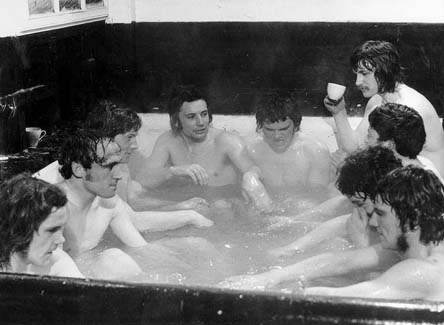
That was the week that was
"Many regard the Frost Programme as a mickey-take but I’m not
so sure – he was genuinely enthusiastic about us doing well that week,"
remembers Don. "The first interviews were to be done at my own home
in Newton Aycliffe. Being a bit nervous, a few of us – me, Steve Holbrook,
Colin Sinclair, Peter Graham and Ernie Adams – went down to the Southern
Club for a bit of Dutch courage - we only intended to have a pint or two.
It was about 6.30pm and quiet in there - we decided to have a game of
darts.
"During the game an old chap
came across and asked us if we were the Darlington players. I said we
were and he asked me to follow him. He took me to the table by the entrance
door and said, “Sign these lot in will you?” When I looked up I couldn’t
believe it – there was David Frost and some of his film crew including
the producer and director! And the old doorman wanted them ‘signed in’
– he hadn’t a clue who they were! "I ‘signed’ them in and apologised saying
we didn’t expect them until 8pm at my house and that we would drink up
our pints. “No! Carry on lads,” Frostie said, “and have another drink
on us! I want to try a pint of that ‘Newcastle Brown Ale’ I’ve heard so
much about but never tasted! "Well, he went on to have a couple and bought
us all some more drinks before he and the crew bought and filled their
pockets with bottles of Newcastle and spirits. He’d had an idea and decided
it would be a good idea to do the players’ interviews as an informal party
get together with our wives – this was two nights before the game but
the rules were different then! By the time we were on camera we were half
sloshed!" David Frost certainly got involved as we can see from the pictures of
him training with the Darlo squad. Unfortunately in the first game covered
by the documentary team, Darlo lost 5-0 at Chester. However a little pride
was restored in the home match with Cambridge when we drew 3-3, Don appearing
on the scoresheet with Norman Lees and Ian Hopkinson.
Don was also involved in another interesting episode in Darlington's
history. Paul Trevillion, a predecessor of Uri Geller (but without the
spoon bending talent) arrived at Darlington and proceeded to tell everyone
that Darlington just needed the sort of confidence he could instill and
they could beat any opponents put in front of them. He even went so far
as to predict that Darlington would beat their next opponents, Cambridge,
5-0l at home!
"It was a strange week when Paul Trevillion came to Darlo.
He was there to ‘psych’ us up but some of thought he was a weirdo! He
got all the TV cameras to Feethams and asked one of us, Gordon Cattrell
(who drew the short straw) to take a penalty and try to knock a top hat
off its leather case holder in front of the cameras. Paul Trevillion said
it was all about’ psychology’ - Catty hit it first time. It wouldn’t have
mattered if he’d missed because Trevillion had a piece of string tied
to it and would have pulled it off anyway!"
The fun didn't end there
either. "He brought the singer Kathy Kirby (a Sixties version of Kylie
Minogue for those too young to remember) into the dressing room after
the game – we were all in the bath and I don’t know who enjoyed it the
most – us or her! She lost a valuable ring that day – she thought it fell
on the floor in the grandstand and went through a gap in the floorboards
and under the stand."
Don was part of the squad that
was featured in a Frost Programme documentary made by London Weekend
Television and presented by David Frost - certainly an unusual choice for
TV coverage in those days when lower division teams got fewer headlines
than today. Cynics suggested that the programme would belittle the Quakers
but Don is not convinced.
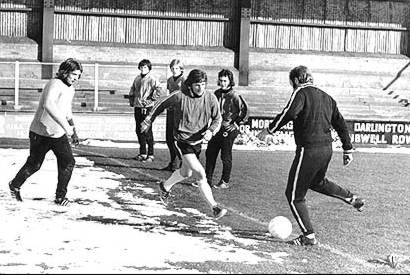
As ever at Darlo, virtually no one thought we could do as well as Trevillion
had predicted. But how wrong we all were. "He must have had some ‘influence’
because we really turned it on against Cambridge, and I think it’s the
best we ever played whil I was there. I scored the best goal of my career
that day and have a photo of me hitting the ball into the bottom corner
(pictured left)– I beat about four men from the halfway line and a couple of them are
still on the floor in the photo after missing their tackles on me!"
A different pair of boots and over the hills
Unfortunately these were the
highlights of Don's career at Feethams and his persistent ankle injury was
to prove too much for the professional game. "It wouldn’t stand up to full-time
training. I managed to play for three more seasons for Whitby Town in the
Rothman’s Northern League. Several ex-Darlo players eventually joined me
there including Stan Webb, Eric Young, Micky Bloor and Alex Smith."
Don has continued to remain active and he now indulges in another outdor
activity - walking - although this wasn't always the case: "I used to
run up and down the NY Moors & Cleveland Hills in my days at the Boro,
but I didn’t appreciate their outstanding natural beauty in those days
– in fact, I was too knackered to look! The hills were more of an ‘enemy’
then than a friend! I only took up walking seriously in about 1994 – after
that, I soon got the ‘bug’.
"I’m told I inherited my love of the Moors through my Grandad, Matty
Pearson. He used to have a horse & cart – he lived at Castleton and used
to supply the remote farms and villages on the Moors with fish & fruit.
I would have loved to have spent a day with him on his travels over the
rough moorland tracks – those same tracks I now tramp regularly." Not
content with simply walking, Don has taken to recording his walks through
another of his early interests - photography: "I’ve always had an interest
in photography since the day my Mam & Dad bought me a Brownie 127 on holiday
in Manchester when I was about nine years old. I think I was lucky enough
to be born with an eye for taking a good photograph – that and being able
to kick a ball. "
Even better, these photographs are available to admire on his own-web
site, North York
Moors CAM . This has proved to be a source of inspiration for many
people around the world, exiled Yorkshire folk such as myself as well
as tourists from far and wide:
Despite his football career ending as it did, Don has few regrets "I
had chances to travel and play for teams abroad in countries such as America,
Australia, South Africa and Belgium. But I never really wanted to leave
the North-East and my family far behind so I chose to stay. I just want
to see my family remain happy and healthy and keep enjoying my walks in
the countryside for as long as I’m fit enough to do so. The day I do dread
is when I have to finally hang up my ‘boots’ once and for all."
* Don's pictorial guide to the Cleveland Way is also available on
CD-ROM for £12 - see his website
for details.
"I get a tremendous amount of feedback
from visitors to my website – hundreds of e-mails and Guestbook entries
have come in from all around the world, many from ex-pats who miss their
‘roots’. I’ve met some lovely new friends from as far away as America,
Australia, Canada, etc and taken them on some of my walks – they absolutely
love the countryside and the people over here!"
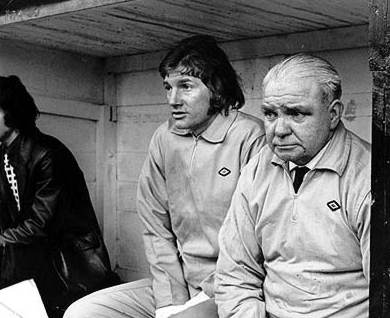
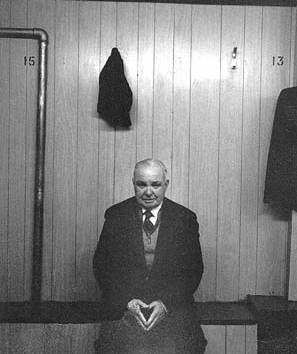
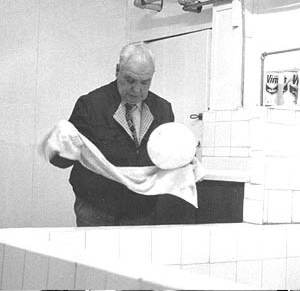
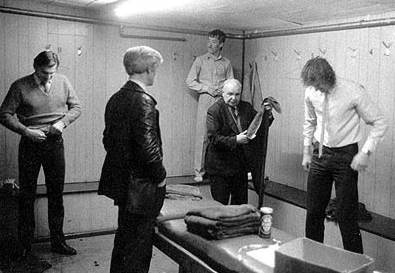
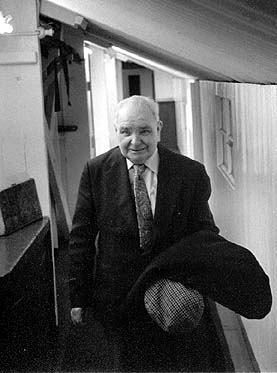 Very few
old photos seem to exist of Feethams in the "old days" - including the
1970s. It seems apart from team photos, there's not a lot around behind
the scenes, with many from the club lost or destroyed. The Northern
Echo has few and the ones they had, they kindly allowed us to display.
The Trust has some reproductions which we have for safe keeping, hopefully
for future generations. We've added these in 2005 as we acquired this
set off eBay. They included a few of the David Frost visit - which we
were familiar with- and others showing former trainer Dickie Deacon. He
was known as a real character, who took players on runs from the ground
into outlying villages, following on his bicycle. As John Peverell recalled,
he told the lads not to run too fast, or he couldn't keep up.
Very few
old photos seem to exist of Feethams in the "old days" - including the
1970s. It seems apart from team photos, there's not a lot around behind
the scenes, with many from the club lost or destroyed. The Northern
Echo has few and the ones they had, they kindly allowed us to display.
The Trust has some reproductions which we have for safe keeping, hopefully
for future generations. We've added these in 2005 as we acquired this
set off eBay. They included a few of the David Frost visit - which we
were familiar with- and others showing former trainer Dickie Deacon. He
was known as a real character, who took players on runs from the ground
into outlying villages, following on his bicycle. As John Peverell recalled,
he told the lads not to run too fast, or he couldn't keep up.
Memories of the 1980's - and born again
To score the winning goal against a
neighbouring 'big' club in the FA Cup is one way to ensure your place in
Darlo folklore but to do it against the team that released you must make
it all the sweeter. And so it was for PHIL LLOYD.
"I was released from Boro by Big Mal (Malcolm Allison) and went onto
the dole, worked on the markets and played for local sides. Then out of
the blue, Knowlesey rang and invited me to train with them,” recalls Lloyd.
"Dave Barton had to retire and Cyril needed a replacement quickly
and cheaply. He remembered me from his days as a coach at Middlesbrough.
I quickly fitted in with his team and methods and signed after just a
few games”. For some players coming to Darlington meant a down-turn in
their fortunes but for Phil, coming to Feethams was like being born-again
“Having spent over 12 months on the football scrapheap, Feethams was like
Wembley to me. The staff were great and I remember Tommo as a kid with
his mum at most games. After all these years I can't remember all the
names but I can picture the faces, and everyone made you feel very welcome.
“ Phil remembers one person in particular “Martin Deans (tunnel steward
since the mid 1980s) was great, what a fan - I still catch up with him
when Darlo play Torquay”. ,The haircuts were a little bit different in
those days. Returning to that game in 1985 which was
voted No.1 in an all time Darlington Top Ten, what does Phil remember
of it all? “I loved being back at the Boro where we managed a draw. Boro
thought they would win the replay hands down but enter various Boro old
boys – Lloyd, Knowles, Angus and McDonald!”. “We gave them a right game
and we won it fair and square. That result will stay with me for the rest
of my life”. Cyril Knowles eventually left Darlo and headed to Torquay.
Phil followed fairly shortly afterwards. “Cyril phoned pre-season and
offered me a chance at Torquay. I didn't want to sound too pleased but
deep down I was elated”. After a few seasons of success – reaching the
play-offs and a Sherpa Van Trophy win at Wembley - Phil suffered an injury
that ended his career. “I played more games for Torquay than Darlo and
probably achieved more with them, but I can honestly say that my time
at Darlo was more enjoyable” Phil is now settled for good in the south-west.
“ I’m very happily married , have a wonderful son, two dogs, sea views
and I don't think there's much will move me from Sunny Devon” “I may not
be able to see the old place again but believe me, my heart will be saying
goodbye to Feethams. Farewell to the stadium that kicked-started my career”. Ted Blair